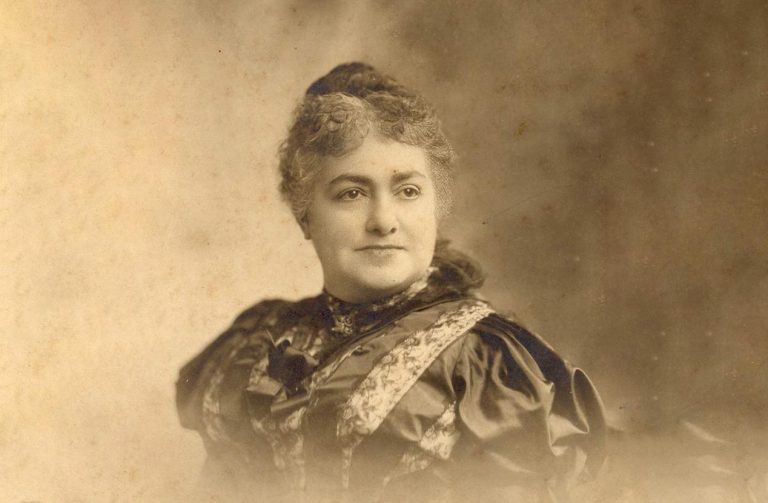Educated, beautiful woman from Camagüey, with big black eyes like thick and soft hair, and with a strong gaze, like her character; that was Ana de Quesada and Loynaz, the daughter of the marriage of Pedro Manuel de Quesada y Quesada and María del Carmen Loynaz y Miranda; a union from which several children would be born, among them, Pedro Manuel de los Dolores Eustaquio de Quesada and Loynaz, who would stand out for being appointed in Guáimaro (April 1969) General in Chief of the Liberation Army.
Ana Valentina de Quesada Loynaz was born in the city of Puerto Príncipe, on February 14th, 1842 and two days later she would be taken to the church of Our Lady of Solitude, to be baptized by the priest Joaquín de Cisneros. To get to this parish of unique architecture, her parents, her brother Manuel, paternal and maternal grandparents, and witnesses, would have left behind the family house located on Reina Street (nowadays, República Street).
Despite the elementary studies that she would receive in the available schools in the city, this girl would show gifts and aptitudes to assimilate the subjects and the manual arts.
After November 4th, 1868, the date of the Camagüey uprising, Anita, as the people at home called her, went to the free Cuba territory with her mother and brothers under the guidance of Pedro Manuel. At the house in Guáimaro, a town where freedom and revolution were breathed in the initial days of the war, she would learn about the poetic and romantic gifts of the lawyer Carlos Manuel de Céspedes, who came from Bayamo to the cultural gatherings and evenings that took place happily in the happy town of “patricians” of Camagüey; site where the Constituent Assembly would be held, in April 1869, and where Céspedes would be sworn in as President of the Republic in Arms.
It was precisely the same day that the patriots of Camagüey had risen the previous year (November 4th), the one selected in the flowery San Diego del Chorrillo in Najasa, so that the “president poet” Carlos Manuel de Céspedes and Ana Valentina would materialize their love . The nuptial ceremony took place with all the nature and the religious solemnity of the official act, which fell to the Mambí prefect Facundo Agüero y Rioseco. The union was consented to by the mambises present there and by relatives of the married couple.
The spouses would spend a short time in that country idyll. Sibanicú, Guáimaro, Najasa, Cubitas … would welcome the married couple during the war. Despite the protection measures taken by the President of the Republic in Arms so that the family would not be captured by Spanish forces, on December 30th, 1870 in the company of his mother, his sister Caridad and Javiera de Varona de Bernal, while they were guided through the mountains by the Cuban agent Juan Clemente Zenea to try to leave the island through La Guanaja estuary, they would be surprised by a Spanish troop at the Santa Rosa de Cubitas sugar mill; they were then taken back to the National Prison of Puerto Principe and from there to the Havana Prison.
Once in the Capital, after obtaining the pardon of the Superior Government in 1871, the family would travel to New York under the protection of patriotic emigration that offered material support to the cause of Cuban independence.
From Céspedes, Ana Valentina had three children who would follow her everywhere, and would make her not forget Cuba and her beloved husband. Oscar had been born in the heat of the insurrection and Gloria de los Dolores and Carlos Manuel, in emigration, having other worthy Cuban women for company.
Despite the sorrow for the death in San Lorenzo of his idolized, with the tears of his heart and the sacrifice of his hands, she paid for the education of her children and offered money and jewels to the Revolution so that the holy cause would succeed, cause that had led her husband to die for Cuba.
Longing for Cuba and eager to see her own after the end of the War of Independence, she would embark for the Greater Antilles to approach the Patriotic Board of Havana, to return the glorious flag of the lone star with which Carlos Manuel had upraised in 1868. She had been jealously guarding the cloth since 1872.
Once in the Cuban capital, she maintained an active presence in forums in defense of the sovereignty and independence of Cuba, accompanying the worthy patriots and countrymen Salvador Cisneros Betancourt, Concha Agramonte Boza, Bernabé Boza Sánchez, Manuel Sanguily Garrite and other worthy combatants of the Cuban struggles.
After spending time in Cuba, however hurt by the vivid memories of the war in which she had lost her husband, she decided to set out on a trip to Paris, where she would see all hope of being able to return to her homeland, however, her hazardous life ended on December 22nd, 1910.
Shortly before leaving for Paris, she said to Salvador Cisneros: “I regret the deep sadness of the dark days we are living in, but I trust the Cuban people in the same way that I judiciously mistrust the masters of the North.” In that nation she had met José Martí and listened to some of her instructive speeches, in which the Apostle alerted the patriotic emigration to prevent in time the island from falling into the entrails of the powerful neighbor.
By coincidences of life, with only hours of difference from the day of the birth of Major Ignacio Agramonte Loynaz, the most respected and admired man by her husband Carlos Manuel, one of the lucky women who had seen the birth of the Republic in Guáimaro died in Paris.
Translated by: Aileen Álvarez García






